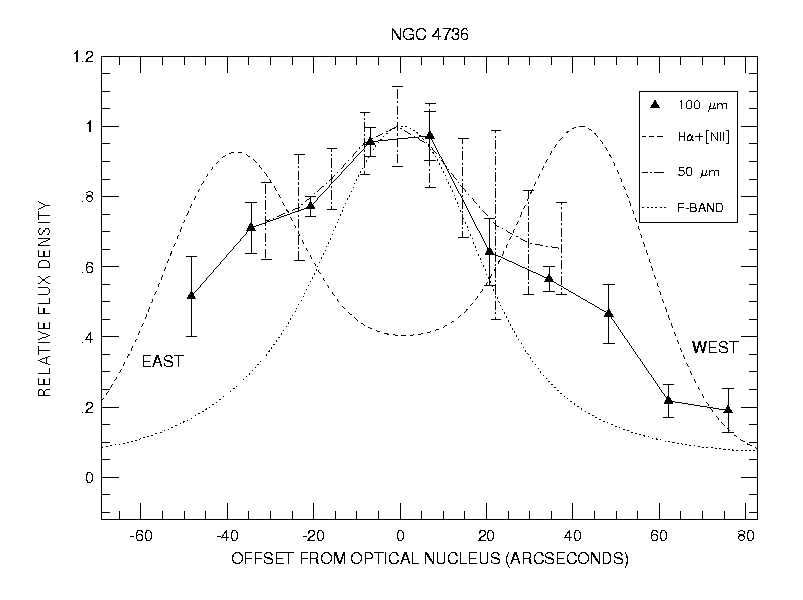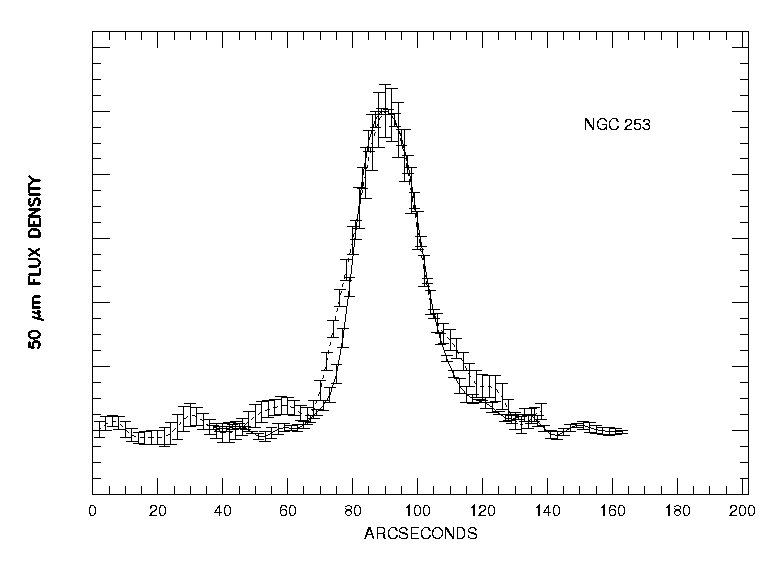
A significant amount (often 10% to 99%) of the total energy emitted from a galaxy is observed at far-infrared wavelengths (40 - 120 microns). This radiation is caused by emission of interstellar dust grains. To understand this emission, it is important to make detailed maps of galaxies at these wavelengths. To obtain far-infrared data at high spatial resolution, in collaboration with Paul Harvey and his group at the University of Texas, I have used the Kuiper Airborne Observatory to observe galaxies at 50 and 100 micron wavelengths with the Texas far-infrared array. I have also used the Caltech Submillimeter Observatory to obtain 350 micron observations of galaxies.
For some recent KAO publications, see my publications list.
Some recent KAO results:

This plot shows a cut across the Sab galaxy NGC 4736 (Messier 94) at 50 microns (dashed/dotted line) and 100 microns (filled triangles), compared to the distribution of light in the optical ionized hydrogen alpha line (H-alpha; 6563 Angstroms) and nitrogen (6584 Angstroms) line (dashed line), and the red continuum (F-band) light (6500 Angstroms; dotted line). The H-alpha and nitrogen lines arises from ionized interstellar gas, which traces the observed distribution of newly formed massive O and B stars. The F-band light is red starlight, and the F-band profile gives the distribution of old stars in the galaxy. This galaxy has a ring of new stars encircling the central bulge at a radius of 40 arcseconds (1.3 kiloparsecs). The bulge of NGC 4736 is mainly composed of older, later type stars. Far-infrared emission arises from dust in the interstellar medium; the fact that the bulge of NGC 4736 is bright in the far-infrared suggests that old stars are important in heating the dust in that region (from Smith et al. 1994, ApJ, 425, 91).

This plot shows our 50 micron profile across the Sc galaxy NGC 253, compared to a cut across Callisto. Callisto is unresolved at the KAO resolution, so measures the beam profile of the instrument. The profile of the galaxy is very similar to that of the beam, which means that the core of the galaxy is compact at 50 microns. Approximately 60 percent of the total far-infrared radiation from NGC 253 arises from the inner 30 arcseconds (500 parsecs). NGC 253 is known from optical and radio studies to have an large number of newly formed O and B stars in its central bulge. The far-infrared in this galaxy, unlike in NGC 4736, is largely due to dust heating by O and B stars rather than lower mass stars. NGC 253 is about a factor of 4 more luminous in the far-infrared than NGC 4736 (from Smith and Harvey 1996, ApJ, 468, 139).
To return to my home page, click here.